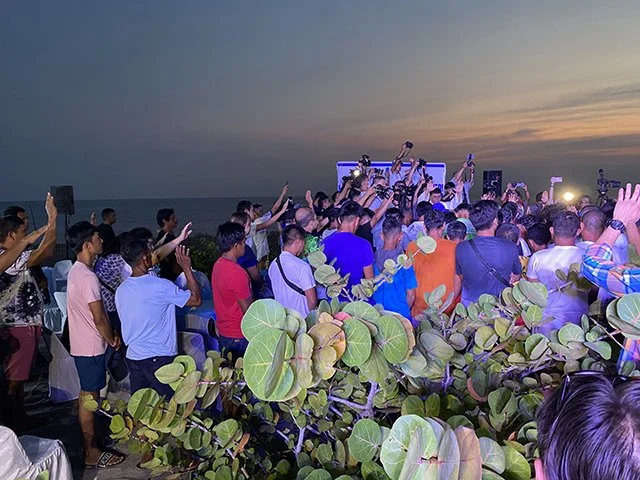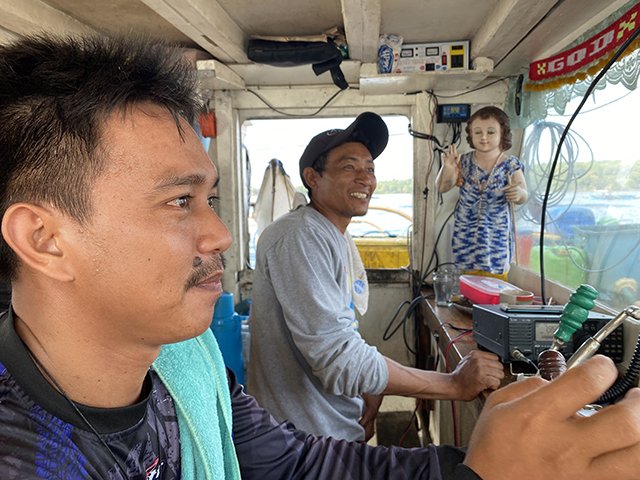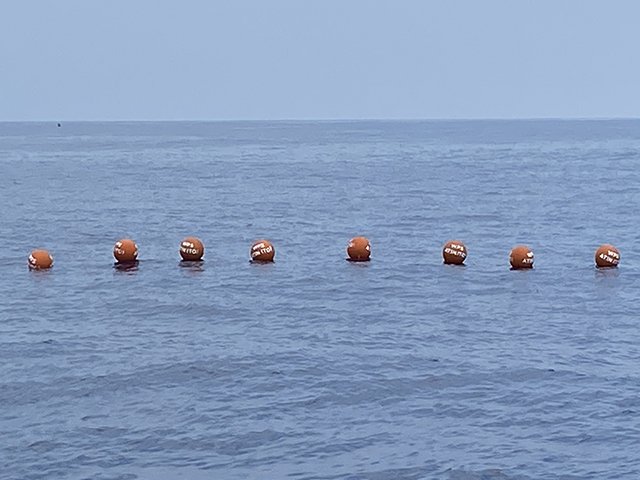Atin Ito! Reclaiming the West Philippine Sea, Round 2
/Atin Ito!
But this is not war. On the contrary, the Atin Ito! missions seek to avert the escalation of hostilities and to “demilitarize” the conflict in the face of increasing Chinese military presence in the seas, islands, and atolls of the West Philippine Sea. They highlight the role of civilians as active citizens staking a claim.
“West Philippine Sea! Atin Ito!"
Though peaceful, it was a hardship assignment nevertheless. The boat we boarded, FB Aguian, was the least provisioned among the five main boats that comprised the voyage. For one, it did not have a toilet. What passed for one, an approximation of a rest room, was a small area at the stern, barely covered by a tattered tarpaulin. You do your thing at the empty space between the wooden pair of outriggers on the portside, and you need to hold on tightly to a protruding pipe, or you’ll fall into the sea, most likely unnoticed. Except for the poor fisherfolk who are quite used to minimal provisions, I doubt if any of the volunteers or media people were able to use this contrivance. In fact, most of them hardly ate during the entire journey, as privately releasing digestive byproduct was a supreme challenge aboard the rundown fishing vessel.
Cramped space aboard FB Aguian
Which was a pity, because the food was much better this time compared with what we had during the first WPS Atin Ito! Civilian Mission. For that first voyage, which attempted to reach the islets around the Ayungin Shoal (aka the 2nd Thomas Shoal) off Palawan, we had a much bigger, much better ship, the T/S Felix Oca. However, due to logistical gaps too complicated to elaborate here, we endured food scarcity, alternating between canned sardines and instant noodles for breakfast, lunch, and dinner. There was some variety when some saba (plantain bananas) and sweet potatoes were hauled in.
https://www.positivelyfilipino.com/magazine/defying-goliath-in-the-west-philippine-sea
For this second voyage, our food was fresh catch excellently prepared by the fisher folk right there on the boat - kinilaw, paksiw (ceviche, vinegared fish stew), or deep-fried to a crisp. These on top of chicken and pork dishes. I devoured all this while the others, trying to escape the necessity of using the “air latrine,” made do with instant noodles and biscuits.
Sleeping, or simply finding a place to sit or lie down with relative comfort, was another hurdle. There were 18 of us volunteers and media onboard FB Aguian, of which I was the team leader, plus the crew of around 10. This kind of boat was locally referred to as a pangulong because this type of fishing vessel entraps (“kulong”) fish inside huge trawling nets. The fish gather around the so-called payao, a fish-aggregating device (FAD) made from submerged coconut stem and fronds tied under buoys anchored to the ocean floor. The act of entrapping and catching fish is called simbada, which they periodically perform once, twice, or thrice a month, depending on how much fish have congregated around the payao. According to Ka Marcelino Tena, one of our fisherfolk leaders on the voyage, they can catch between two to five tons of fish per simbada.
Apart from warm bodies, the boat was overstuffed with ropes, fishing gear, water tanks, fuel tanks, food supplies, and a swarm of other knickknacks competing for space. Sleeping in a normal position was impossible, with everyone trying to find the best possible body contortion under the circumstances. During the day, we constantly moved about, trying to avoid the blazing sunlight by hiding under the limited and constantly shifting shade. This was definitely the most spartan living condition I have had to endure since I came down from the hills more than 30 years ago.
Day 1: Off to Zambales
At the break of dawn on Tuesday, May 14, 2024, we assembled at the Philippine Rural Reconstruction (PRRM) office in Quezon City and left in three buses at 6:20 a.m., northwest bound. There was a brief stopover at Lubao, Pampanga for breakfast before proceeding to the Sambali Beach Farm in Botolan, Zambales. The farm’s owner, Philip Camara, is a former Department of Environment and Natural Resources (DENR) Undersecretary and one of the country’s stalwarts of organic farming and environmental advocacy. He fully supports this mission, seeing firsthand the Chinese incursions into the Zambales side of the West Philippine Sea and how the fisherfolk have been increasingly driven away from their former sources of livelihood.
Before sailing
Briefings for volunteers and media were done at the Sambali, including boat assignments, security measures, and contingencies. And then there was the send-off mass officiated by the “running priest” Fr. Robert Reyes, with Pakistani Father Moon Sohail, and Sri Lankan priest Fr. Sebastian Lambert, all expressing solidarity and praying for fortitude. It was followed by a short program where the mission’s key leaders Ed dela Torre, PRRM President, and Rafaela David, Akbayan Citizens Action Party president and mission co-convenor, and others delivered rousing speeches and gave last minute instructions, such as what to do in case of inclement weather or hostile presence. By evening after dinner, we tried to snatch a couple of hours’ sleep. I envied the loud snorers because I couldn’t sleep, probably owing to the adrenaline-fueled excitement.
Sunset mass before the voyage.
Fisherfolk being blessed prior to the mission.
Day 2: All Aboard!
By 3 a.m. everyone was up again. We boarded our buses for the hour-long trip to Matalbis Port in Masinloc, Zambales. There were five boats, and each boat had one team leader, one boat captain, one volunteer management officer, and one logistics officer, plus the media and the boat crew. Our boat captain was Maximo Aguian, a seasoned sea traveler whose family owned a number of pangulongs. Our volunteer manager and logistics head were both very young and have yet to graduate from college: Frank Araneta and Jenny Tugade-Jabon, respectively. Both had the eagerness and boundless energy typical of the politically woke youth.
Boat captain Maximo Aguian (left) and his machinist.
Volunteer manager Frank Araneta and logistics manager Jenny Tugade-Jabon
At around 7:30 a.m. we left Matalbis port towards the direction of Bajo de Masinloc, aka the Scarborough Shoal and the Panatag Shoal. I flipped out my mobile and turned on my FB Live to catch live the start of the sea voyage, panning it around the seascape and randomly asking questions to whoever in our boat catches its view. In the middle of my FB Live I looked to my left and froze! It was a magnificent spectacle: scores of fishermen’s small boats racing alongside our bigger vessel in a synchronous beat, a la regatta. It was a powerful image I failed to capture on my mobile. Good thing we had press people who had drones documenting this visual feast and converting it into a wonderful video material. https://fb.watch/t7jle0-pvc/?mibextid=oFDknk
The author climbing the small boat. (Photo from Oliver Teves)
I turned to my volunteer manager and asked, “How did you find that?”
“Naiyak po ako” (“I was in tears”), Jenny said. I was a bit affected myself.
Thirty minutes into the open sea, our boat’s engine conked out. Good thing the other boat, FB John, whose team was led by colleague Argee Esquejo, was there to lend a hand. A tow rope was thrown overboard, and we were pulled until our engine was fixed. Then came the next leg of the mission: releasing of symbolic buoys into the sea where the words: “WPS: Atin Ito!” (It is Ours) are inscribed. While stationary, we proceeded to hand out the ayuda, or the direct assistance, to fisherfolk in the Masinloc area, comprising food packs and fuel. After which we proceeded further westward to the Bajo as the sun set slowly in front of us.
WPS Atin Ito! buoys.
By 6:15 p.m., 80 kilometers out of the Matalbis port, we spotted a gray apparition on the horizon that got clearer as it came closer. A Chinese vessel, unmistakably, with another one appearing on the other side. No less than three Chinese Coast Guard ships shadowed us all the way. This was not unexpected, of course, and they can always invoke freedom of navigation in open waters, even within so-called exclusive economic zones. We geared up for a battle of wits and wills. It was uneventful, though. We went on our merry way with escorts on all sides all night.
I had a sound sleep that night owing to the fatigue and sleep deprivation the previous night, despite the prohibitive space in our small, rickety pangulong. Some, like seasoned journalists Oliver Teves, Jun Bandayrel, and Edwin Bacasmas were able to secure a sweet spot on the elevated portion in the middle of the boat. Others, like Buena Bernal and her Channel News Asia (CNA) team, occupied the front deck where they laid their sleeping bags. I plopped my body at an awkward angle on the slatted platform next to the outrigger.
Day 3: Wet and Wonderful
At 5 a.m. I woke up with lumbar pain, for obvious reasons. I clambered down from my perch, surveyed the early dawn scenery, and saw that we were stationary. The simbada was already underway! I decided that I won’t let this affair pass without partaking in it. I checked with the boat crew and colleagues. Having ascertained that the “coast is clear” so to speak, I took off my shirt, wore my goggles, and plunged into the sea. I swam around, first around our boat, then around the fishing net, observing their ways but not really expecting to learn it outright. I was fascinated, contemplating the sea’s bounties and our fisherfolk’s simple lives and complex struggles.
I then swam towards a small boat stationed in the middle of the net, which I assumed the payao was attached. Near the boat was CNA journalist Buena, who also went in the water with her underwater camera, mounted on a selfie stick. Buena started fielding questions for her assignment as her camera rolled. https://youtu.be/Z1NqpIzHqpk?si=qfWixe8oV48WfCqt Someone handed me a Philippine flag, asking if I could hold it out for the Chinese Coast Guard to see. I took the flag and flashed it in the direction of the Chinese Coast Guard ship.
Displaying the Philippine flag in the direction of the Chinese Coast Guard. (Photo from Argee Esquejo)
By late morning of the second day, I got a call from Akbayan Party Vice President Emman Hizon, the operation’s communications chief, saying that an advance boat had already reached the waters near the Panatag Shoal way ahead of us and distributed goods there. That was, in fact, the strategy, a deft move to ensure that the distribution would happen, while our bigger contingent served as a decoy to attract the attention of the Chinese Coast Guard. With this part of the mission accomplished, we all turned back and headed for the long trip back to Zambales - this time in the direction of Subic. At 11:30 a.m., we held synchronized prayers. Our boat’s lead priest was Fr. Moon from Pakistan, who led the throwing of blessed medallions to the sea. We also gave out the remaining supplies for distribution to other fisherfolk we encountered on the way to Subic.
Day 4: Back on Dry Land, Message Delivered
At one past midnight of May 16, we arrived at Subic port. We dropped anchor at the Bulungan port, inside Subic, Zambales.
“Why did you join this trip?” asked the media people with us while onboard FB Aguian.
“Because I enjoyed it the first time,” I replied. I was only half-joking. The first civilian mission to the West Philippine Sea we launched last December was a one-of-a-kind experience worth doing again. We had a lot of difficulties then, the scarcity of food, the sudden decision of the captain to turn back, the uncertainty and doubt, among others. That mission nearly failed, if not for the heroics of Mac Hogan, the captain of the smaller boat called M/L Chowee carrying the bulk of the supplies which made it stealthily to the target destination near the Ayungin Shoal.
We spotted a gray apparition on the horizon that got clearer as it came closer. A Chinese vessel, unmistakably, with another one appearing on the other side. No less than three Chinese Coast Guard ships shadowed us all the way.
Atin Ito! Part 2 was far more ambitious and, as we realized at sea, had more difficulties logistics-wise. In fact, the danger of falling overboard from precarious places on the boat was very real. I asked one of the crew: “In case someone falls at night while the boat is moving, will the splash be heard?”
He said not likely, especially not with the ear-splitting racket of the boat’s motor. “So, what can I do if I fall and get left behind in the middle of the ocean at night? Am I doomed?”
“Swim to the nearest light you see. That may be a boat, possibly with a fisherman. Or at the very least, a buoy - which you can hold on to while awaiting rescue.” Thus, I learned another life-hack.
Time spent at sea was also an occasion to reflect deeper on this new struggle. However you cut it, this is a clear case of right vs. might. Look at the map and you’ll see that the Panatag Shoal, among many other rocks in that expanse of sea, lies closest to the Philippines, 220 km, to be exact, from the western coast of Masinloc. It’s well within our so-called exclusive economic zone. China’s southernmost tip, their closest territory to the shoal, is easily 1,000 km away. They argue, however, that they’ve been plying these waters and shoals “since ancient times.” But so did our ancestors. That is not a valid argument, for the world has moved on from ancient times. Borders have been fought over, created, redefined, and agreed upon. We have developed something called international law. The UNCLOS (1982) was one such law, which both the Philippines and China, among many other countries, signed and ratified. That law provides for mechanisms to resolve conflicts, such as arbitration processes. Guided by such legitimate process, the Philippines followed procedure, initiated a case, and won.
But apparently, China would follow a mechanism they previously committed to only when it decides in their favor. It’s the classic playbook of the powerful. Faced with such obstinacy and whim, what can we do? Can they blame us then when we seek allies? But more than that, there are actions we can take, arenas of struggle we can enter such as what we did on this mission. We can exercise our civilian rights in these territories, normalize travel and the use of our own waters and maritime features. We can take a stand. Dive in our waters. Flash our flags in defiance. Assert! Or get wet trying.
(All photos by Bobby Garcia, unless otherwise indicated.)
Bobby is the author of To Suffer thy Comrades: How the Revolution Decimated its Own. He was Undersecretary at the Office of the Political Adviser for President Benigno S. Aquino, Jr. – under whose term the Philippines filed the WPS territorial claim with the Permanent Court of Arbitration.
He presently leads the Technical Assistance Team of Governance in Justice (GOJUST) II – Human Rights, supporting the Commission on Human Rights (CHR) through funds from the European Union (EU) and the Agency for International Development Cooperation (AECID) of Spain.
He joined the Atin Ito! first and second civilian mission to the West Philippine Sea as an individual volunteer and as a member of Akbayan.
More articles by Robert Francis Garcia














